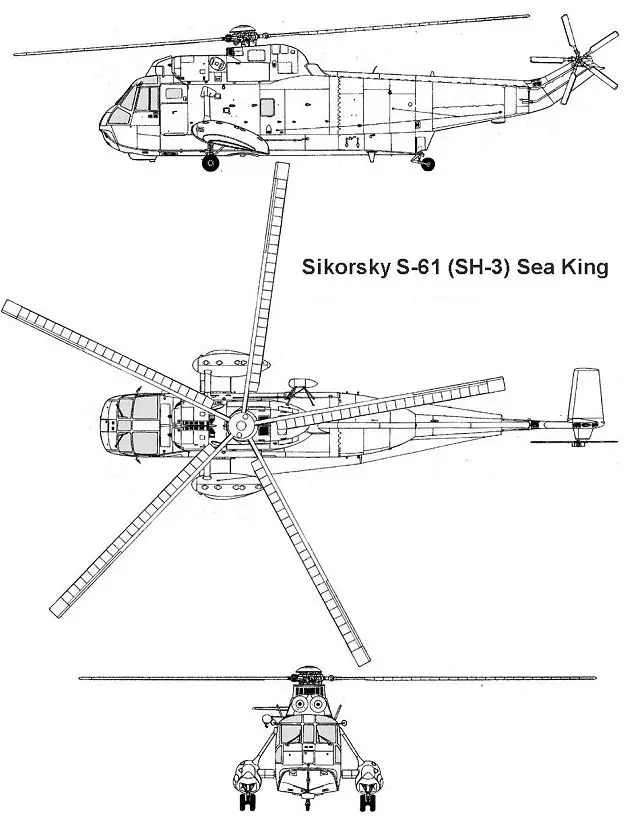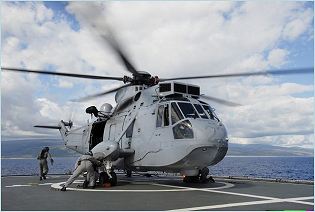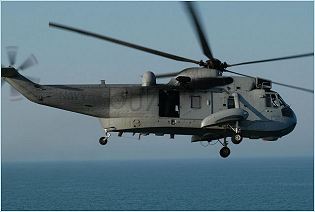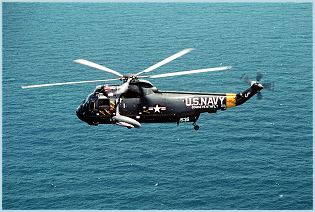S-61 SH-3 Sea King Sikorsky
| a | ||||||||||||||||||||||
|
S-61 SH-3 Sea King Sikorsky Anti-submarine warfare helicopter
|
||||||||||||||||||||||
 |
||||||||||||||||||||||
|
|
||||||||||||||||||||||
|
The SH-3 Sea King (company designation S-61) is a twin-engined anti-submarine warfare (ASW) helicopter designed and manufactured by the American Company Sikorsky. Designed to combine the hunter/ killer functions in one airframe, the Sikorsky HSS-2 was the subject of a US Navy contract awarded on 23 September 1957. This called for an all-weather anti-submarine helicopter with dunking sonar' equipment and able to carry up to 381 kg of offensive weapons. The S-61 design had watertight hull, retractable landing gear in the stabilizing floats, and was powered bytwo General Electric T58 turboshaft engines driving a five-blade main rotor. The prototype flew on 11 March 1959 and seven YHSS-2 trials aircraft followed; the type became redesignated SH-3 in September 1959. The initial production version, the SH-3A Sea King, began to reach Fleet squadrons in September 1961 and later conversions included the HH-3A VIP transport flown by the Executive Flight Detachment, Washington. The essentially similar CH-124 was supplied to Canada while the Royal Norwegian air force acquired S-61A helicopters without ASW equipment for rescue duties, and the Royal Malaysian air force acquired S-61A-4 Nuri helicopters equipped to carry 31 troops or operate in the SAR (Search And Rescue) role. |
||||||||||||||||||||||
| Main Variants | ||||||||||||||||||||||
|
- S-61L: Non-amphibious civil transport version. It can seat up to 30 passengers (13 Built).
- S-61L: Mk II Improved version of the S-61L helicopter, equipped with cargo bins. - S-61N: Amphibious civil transport version. - S-61N Mk II: Improved version of the S-61N helicopter. - S-61 Payloader: Stripped down machine optimised for aerial crane work; features the fixed undercarriage of the S-61L, but with an empty weight almost 900 kg (2,000 lb) less than the standard S-61N. - S-61 Shortsky: Shortened conversion of the S-61L and S-61N, designed to increase single engine performance and external payload. - S-61T Triton: S-61 modernized upgrade by Sikorsky and Carson; Upgrades include composite main rotor blades, full airframe structural refurbishment, conversion of folding rotor head to non-folding, new modular wiring harness, Cobham glass cockpit avionics; initial models converted were S-61N. - SH-3D: More fuel and the replacement of the original 1,250-shp (932-kW) T58-GE-8B engines by 1,400-shp (1044- kW) T58-GE-10s. - ASH-3D: SH-3D manufactured under license in Italy by Agusta-Sikorsky - SH-3G: AWS (Anti-Submarine Warfare) equipment removed - SG-3H: with updated ASW and electronic surveillance equipment - CH-3B: a denavalized SH-3 - CH-3C: number of major changes including a rear loading ramp. - HH-3F Pelican: with advanced electronic equipment for SAR duties |
||||||||||||||||||||||
| Technical Data | ||||||||||||||||||||||
| Design | ||||||||||||||||||||||
|
Sea Kings operating in an anti-submarine capacity typically had a four man crew; a pilot and copilot in the cockpit and two aircrew in the cabin area to operate and monitor the aircraft's detection equipment and to interpret the sensor data; the two rear aircrew were retained in other mission roles such as cargo transfer and rescue operations. The cabin can accommodate up to 22 survivors or nine stretchers in addition to two medical officers in a SAR capacity; up to 28 soldiers can be accommodated when operated as a troop transport. The Sea King features many design elements to support naval-orientated operations; the main rotor blades and the tail section could be folded for storage when deployed onboard ships. An amphibious hull allows most Sea Kings to land on and remain on the ocean's surface as a matter of operational routine; for stability and increased flotation, the aircraft's sponsons contain deployable airbags for use when the Sea King planned to come into direct contact with the sea.
|
||||||||||||||||||||||
| Avionics | ||||||||||||||||||||||
|
The ASW helicopter is equipped with two type 4 marine markers, two mk2 smoke floats and mini-sonobuoys supplied by Ultra Electronics. BAE Systems type 2069 sonar with an AQS-902G-DS acoustic signal processor provides the capability to carry out dipping sonar operations to a depth of 700ft. The magnetic anomaly detector is the AN/ASQ-504(V) AIMS supplied by CAE Electronics. The Thales Defence Super Searcher radar is installed on the mk6 fleet of Sea Kings built for the UK Fleet Air Arm. The helicopter is also equipped with the joint tactical information distribution system (JTIDS) terminal IDS-2000 from Rockwell Collins. The helicopter's navigation systems include the Thales Defence Doppler 71 navigation radar, Honeywell AN/APN-171 radar altimeter and mk31 automatic flight control system from Smiths Newmark.
|
||||||||||||||||||||||
| Propulsion | ||||||||||||||||||||||
|
The SH-3 Sea King helicopter is powered by two Rolls-Royce Gnome H1400-1T turboshaft engines, which provide 1,238kW of output power. The six flexible bag fuel tanks hold 3,700l of fuel, which gives the helicopter a range of 1,500km. For long-range operation, an auxiliary fuel tank can be fitted internally to extend the ferry range to 1,750km.
|
||||||||||||||||||||||
| Armament | ||||||||||||||||||||||
|
The SH3 Sea King can carry four torpedoes, either ATK (formerly Alliant Techsystems) mk46, Whitehead A244S or BAE Systems Stingray torpedoes. It can also be armed with four mk11 depth charges. The SH-3 can carry also two anti-ship missiles, either Sea Eagle or Exocet. Sea Eagle from MBDA (formerly Matra BAe Dynamics, UK) is an all-weather, fire-and-forget, sea-skimming anti-ship missile, with a range of 100km. Guidance is by inertial navigation system with active radar homing
|
||||||||||||||||||||||
| Specifications | ||||||||||||||||||||||
|
||||||||||||||||||||||
 |
||||||||||||||||||||||
|
||||||||||||||||||||||































